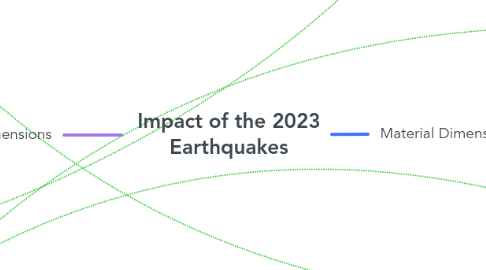
1. Idealistic Dimensions
1.1. Ethical
1.1.1. Corruption in construction
1.1.2. Fear of future disasters
1.1.3. Lack of accountability
1.1.4. Selective media coverage
1.1.5. Unethical Construction practices
1.1.6. Fairness in disaster relief
1.1.6.1. Inequitable resource distribution
1.1.7. Lack of Ethical responsibility for mental health support
1.2. Political
1.2.1. Government policies
1.2.2. Political corruption
1.2.3. Political Prioritization of short term gains
1.2.4. Use of disasters of political gain
1.2.5. International aid dependency instead of improving own policies
1.2.6. Disaster management failures
1.2.7. Weak policy enforcement
1.3. Cultural
1.3.1. Building practices
1.3.2. Uncertain community preparedness
1.3.3. Lack of earthquake prioritizing in community
1.3.4. Loss of cultural heritage
1.3.4.1. Loss of cultural identity
1.3.4.2. Distruption of traditions and practises
1.3.4.3. Impact on collective memory
1.3.5. Cultural preference for rapid urbanization
2. Material Dimensions
2.1. Functional
2.1.1. Weak infrastructure
2.1.2. Poor urban planning in high risk areas
2.1.3. Poor construction quality
2.1.4. Aging buildings
2.1.5. Unregulated construction
2.1.5.1. Building code violations
2.1.6. Lack of warning systems
2.1.7. Inefficient transportation networks
2.1.8. Insufficient gathering spaces
2.1.9. Insufficient healthcare facilities
2.1.10. High population density
2.2. Economical
2.2.1. Economic losses in affected region
2.2.2. High reconstruction costs
2.2.3. Cost-cutting in construction
2.2.4. Economic inequality
2.2.5. Inadequate of insurance crisis
2.2.6. Impact on Tourism
2.2.7. Long-term economic downturn
2.2.7.1. Loss of business and decline in trade and industry
2.3. Social
2.3.1. Displacement of communities
2.3.2. Social Inequality
2.3.2.1. Unequal access to safe housing
2.3.3. Lack of emergency response
2.3.4. Misinformation and panic on social media
2.3.5. Worsened post-earthquake medical crisis
2.3.6. Loss of loved ones and homes
2.3.7. High number of casualties
2.4. Environmental
2.4.1. Soil instability
2.4.2. Destruction of natural landscapes.
2.4.3. Geographical location
2.4.3.1. Urban expansion onto a seismically active zone
2.4.3.1.1. High risk of building collapse
2.4.4. Ecological damage
2.4.5. Waste management crisis
2.5. Psychological
2.5.1. Psychological trauma
2.5.2. Over confidence in existing structures
2.5.3. Fear of economic loss
2.5.4. fear of future disasters
2.5.5. Loss of security
